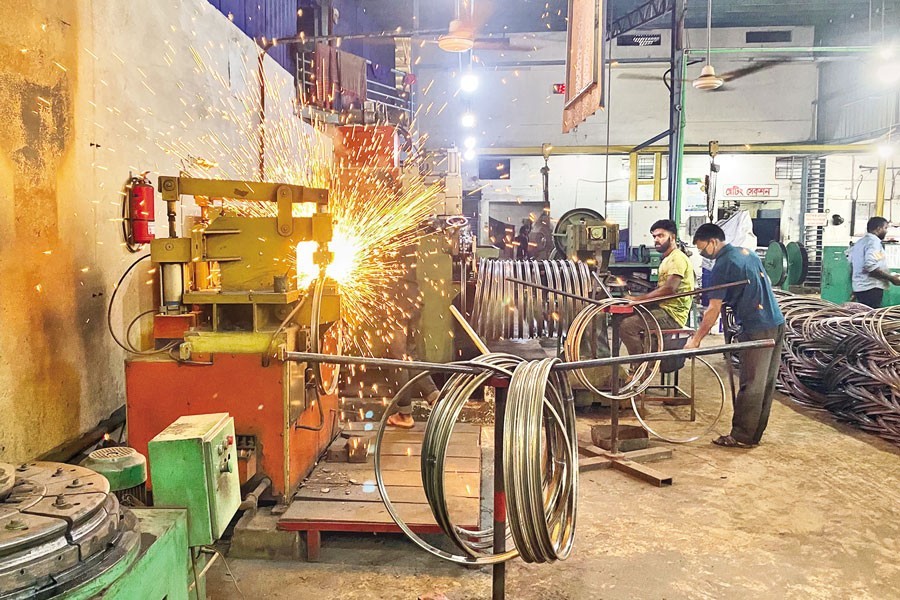
Published :
Updated :

Of the few prospective manufacturing sectors to emerge in the past two-three decades, light engineering stands out. Given the many hurdles this sector -- comprising a cluster of sub-sectors -- has to grapple with, its progress is quite impressive. At a seminar organised by the Dhaka Chamber last week, speakers, while lauding the growth of the sector in a short time, pointed at some problems which need to be addressed for making the sector sustainable. Of the issues raised at the seminar requiring government's attention, research, innovation and consistency of policy have been identified as the key to fostering the growth of the sector.
Now that light engineering is making its importance felt more strongly than ever, there is definitely a lot more to be done to nurture and promote this sector. What, however, is still to come to promote the sector is a sound government policy in order to addresses the existing problems facing the industry, as well as set a roadmap for its growth up to the desired level. Along with a proper policy, the need for research and innovation as pointed out at the seminar is extremely crucial. The machine tools and scores of accessories being produced in various light engineering units are basically replicas with barely any research input. It is because of the lack of innovation that the industry is yet to attain the stage where it can create demand for its own brand of homemade products of good quality.
Industry insiders believe that the right thrust on standard and quality will only be possible with a comprehensive policy in place. Higher duty on raw materials, a lack of advanced technology and initiatives of market expansion, both at domestic and international levels, are encumbering the light engineering sector. Small and medium enterprises are facing obstacles like a lack of advanced technology, skilled workers, market promotion and product diversification. Besides, a lack of infrastructure and limited access to loans are the major deterrents to the growth and expansion of the sector.
So far the sector has achieved modest growth but given the immense potential, it is far from assuming the role it is supposed to take. Although mostly informal with unregulated scope and pattern of work, light engineering is often recognised as a prospective driver of economic activities that not only helps millions of small businesses to thrive but also equally importantly, serves as a backyard for manufacturing scores of engineering products. As a feeder industry, light engineering produces machines, equipment, tools of heterogonous varieties for domestic use in mills, factories and engineering workshops. Besides providing cost-cutting benefits to the consumers, its all-important role is in saving foreign exchange that otherwise the country would have to spend on imports.
It is estimated that the sector currently accounts for around 50 per cent substitutes of imported machine-tools in the country. This is reflected in the support it provides to industrial, agricultural and construction sectors by manufacturing a wide range of spare parts, castings, moulds and dices, oil and gas pipeline fittings and light machinery, as well as repairing those. The sector contributes about 3.0 per cent to the GDP and it is growing at 10 per cent every year, according to the keynote paper presented in the seminar. In FY 2021-22, export of light engineering sector was worth $796 million. Equally significant is its role in job creation. Rough estimates suggest as many as 600,000 skilled and semi-skilled workers are employed by around 40,000 micro enterprises and 10,000 small and medium enterprises (SMES) under this sector. The sector is reportedly manufacturing products worth Tk 250 billion with local technology. The Business Promotion Council, operating under the commerce ministry, estimates that local light engineering industries produce 3,815 types of machinery, spares and accessories.
Despite this bright and laudable role, the downside of the sector is its inability to assume an institutional shape. In order for the sector to attain institutional shape as well as desired growth and diversification, the key requirements are government's policy support, public-private joint initiatives for institutional and financial assistance, availability of technical and business information, innovation and upgrading of technology, capacity building, research and development facilities and removal of a host of growth-impeding factors.
A news item, published in this newspaper some time ago highlighted some of the prospects as well as the enormous potential of the sector that could be capitalised for its growth as a major import-substitution industry. Quoting experts, it said that by investing Tk 60 billion in the improvement of the light engineering sector in a planned and targeted manner, it is possible for the country to save Tk 650 billion on import substitutes of light engineering products every year. This also conversely implies that if the light engineering units, spread out all over the country, are not taken care of immediately to suit the varying demands of the consumers, imported products would soon seize the domestic market. Introduction of appropriate technology for modernisation of the sector should be given priority for boosting its competitive edge before others capture the niche markets. This is how the sector can stamp its own identity on its products.


 For all latest news, follow The Financial Express Google News channel.
For all latest news, follow The Financial Express Google News channel.